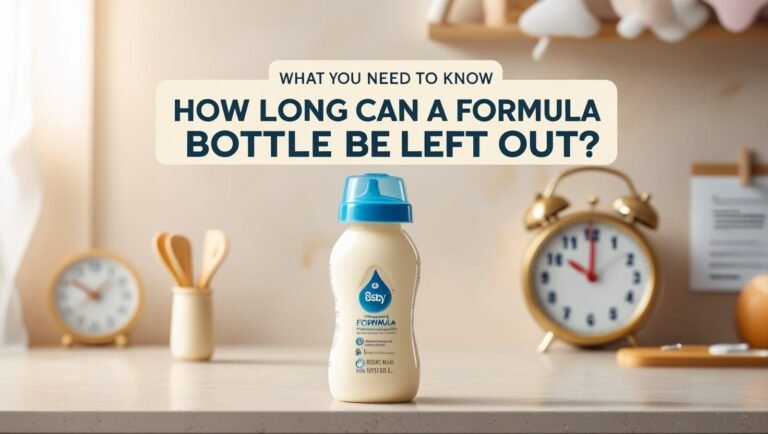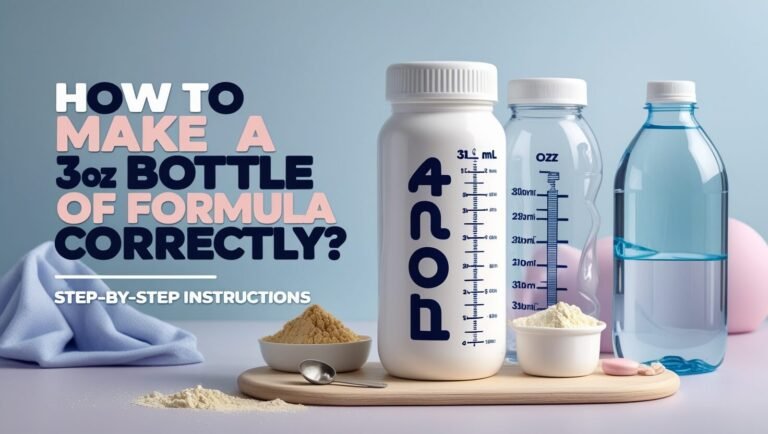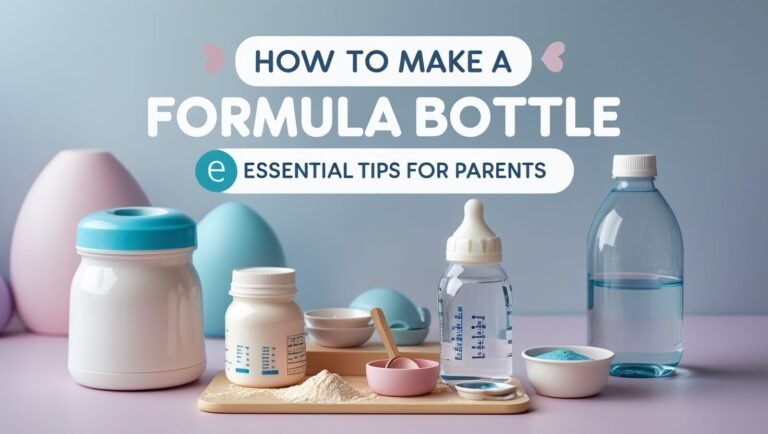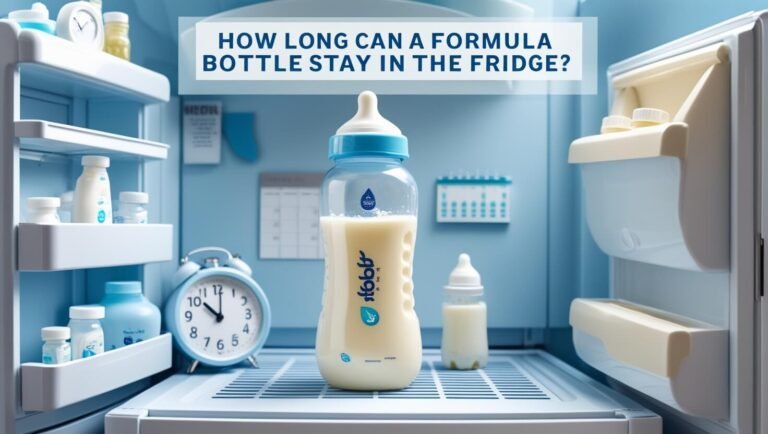How to Make a 5oz Bottle of Formula?
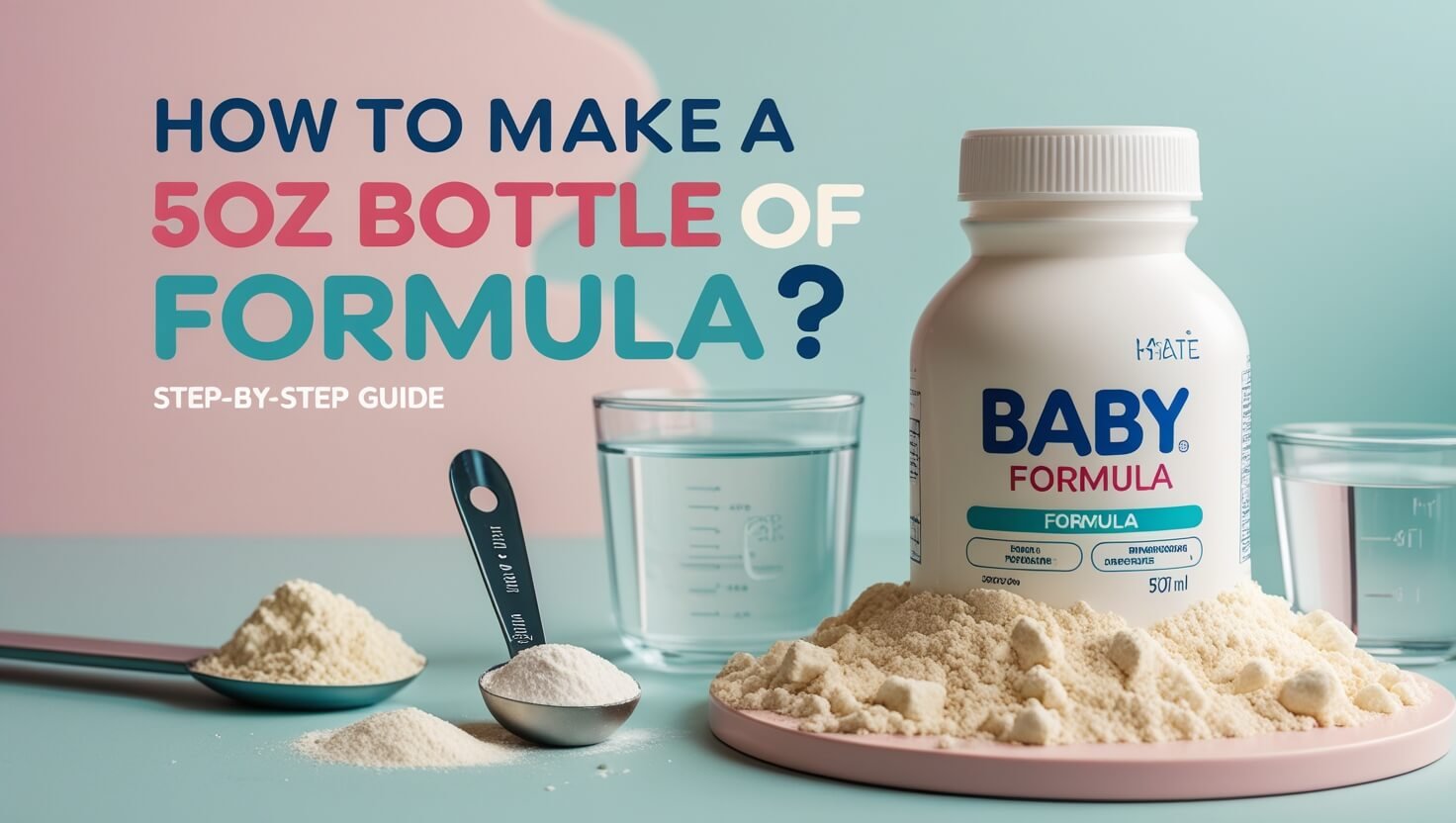
Are you curious about making a 5oz bottle of formula for your baby? You might wonder about the safe and healthy steps involved. To make a 5oz bottle, you need to mix water and formula powder in a 2:1 ratio. This can be tricky, but it’s key for new parents.
The cost of formula can change based on the brand. On average, a 5oz bottle costs between $0.50 and $1.00. It’s important to follow the right steps to feed your baby formula safely and healthily.
As a parent, you want your baby to get the nutrients they need. Learning to make a 5oz bottle of formula is a big step. With the right tips, you can give your baby a healthy start. This article will guide you through making a 5oz bottle of formula. We’ll cover topics like formula types, measuring, water selection, and temperature. This will help you with your baby’s formula preparation and feeding.
Formula Safety Standards and Preparation Space
Preparing a 5oz bottle of formula needs to follow formula safety standards. This ensures the baby’s health. It’s important to have a clean and safe preparation space. Online forums show that parents stress the need for hand washing techniques and sterilizing the work area.
To keep the space safe, you need the right tools. This includes a bottle brush and a measuring scoop. By washing hands properly and sterilizing the area, parents can lower the risk of contamination. This makes sure the baby’s formula is safe and healthy.
Proper Hand Washing Techniques
Washing your hands well is key. Use soap and water for at least 20 seconds. This step helps stop bacteria and other harmful germs from spreading.
Sterilizing Your Work Area
Sterilizing the work area is also vital. Clean all surfaces with soap and water. Then, use a mix of equal parts water and white vinegar to sterilize them.
Required Tools and Equipment
Here’s what you need to prepare a 5oz bottle of formula:
- Bottle brush
- Measuring scoop
- Formula container
- Water container
- Sterilizing solution
| Tool/Equipment | Purpose |
|---|---|
| Bottle brush | Cleaning the bottle |
| Measuring scoop | Measuring the formula |
| Formula container | Storing the formula |
| Water container | Storing the water |
| Sterilizing solution | Sterilizing the work area |
Water Selection and Temperature Requirements
Choosing the right water is key when making a 5oz bottle of formula. The water should be fresh and clean. It should be between 100°F to 110°F (38°C to 43°C). This helps prevent harmful bacteria and microorganisms from growing.
Many parents wonder about the best water for formula. Luckily, city water is safe for making one bottle at a time. But, babies under 6 months should not have extra water.
Here are some tips for choosing the right water and temperature:
- Use distilled bottled water or boiled tap water for mixing infant formula to ensure safety.
- Check the formula container for recommended water temperature and volume.
- Avoid using microwaved water, as it can create hot spots that can burn the baby’s mouth.
Parents can ensure their baby’s formula is safe and meets their needs by following these guidelines.
| Age | Feeding Amount | Feeding Interval |
|---|---|---|
| Newborns | 1-2 ounces | Every 2-3 hours |
| 1-month-olds | 3-4 ounces | Every 2-3 hours |
| 2-month-olds | 5 ounces | Every 2-3 hours |
Formula Types and Measurement Guidelines
Understanding the different types of infant formula is key. You’ll find powder, concentrated, and ready-to-feed formulas. Each has its own way to measure, ensuring the formula is made right.
For powder formula, use one scoop for every 2 ounces of water. This ratio is important for your baby’s health and growth. Concentrated formula needs a specific amount for each ounce of water. It’s important to follow these guidelines to keep your baby safe.
Understanding Powder Formula Ratios
The right ratio for powder formula is 1 scoop for 2 ounces of water. This mix gives your baby the right amount of calories and nutrients.
Concentrated Formula Measurements
Concentrated formula needs a specific amount for each ounce of water. Always check the brand’s instructions for the exact measurement. This ensures your baby gets the right amount of formula.
| Formula Type | Measurement Guidelines |
|---|---|
| Powder Formula | 1 level scoop of powder for every 2 fluid ounces of water |
| Concentrated Formula | Specific amount of formula for every ounce of water (varies by brand and type) |
| Ready-to-Feed Formula | No measurement required, ready to use |
Check the manufacturer’s instructions to ensure your baby gets the nutrients they need. Talk to a pediatrician with any questions.
Step-by-Step: How to Make a 5oz Bottle of Formula
To make a 5oz bottle of formula, you need to follow a step-by-step guide. It’s important to be careful and follow safety rules. First, wash your hands with soap and water. Then, sterilize the area where you’ll be working.
Measuring the right amount of formula and water is key. Many people forget that adding a scoop of formula increases the volume. To get it right, use the ratio suggested by the formula’s maker.
Here are the main steps to make a 5oz bottle of formula:
- Boil water and let it cool for 30 minutes to ensure it’s safe for use.
- Measure out the correct amount of formula and water, taking into account the increase in volume after mixing.
- Mix the formula according to the manufacturer’s instructions, usually found on the formula tin.
- Test the temperature of the formula to ensure it’s not too hot for the baby to drink.
Follow this guide to prepare your baby’s formula correctly and safely. Always follow the instructions on the formula tin and take precautions to avoid contamination. With practice, making a 5oz bottle will become easy, and you’ll be confident in feeding your baby.
| Formula Type | Water Ratio | Instructions |
|---|---|---|
| Powder Formula | 1 scoop : 1 oz water | Mix according to manufacturer’s instructions |
| Concentrated Formula | 1 part formula : 1 part water | Shake well before use |
Bottle Preparation Techniques
Preparing a bottle of formula is important. Proper assembly methods help mix the formula right and make the bottle safe for the baby. It’s key to follow the maker’s guide for putting the bottle together and check the flow rate to avoid leaks.
Parents can follow simple steps to prepare the bottle. First, wash hands and keep the area clean. Then, put the bottle together as the maker says, making sure it’s tight. Lastly, test the flow rate by tilting the bottle. This ensures the formula flows well without leaking.
Key Considerations for Bottle Preparation
Some important things to think about when preparing a bottle include:
- Using the right water temperature to stop bacteria growth
- Adding the right amount of formula to the water for the correct mix
- Shaking or stirring the bottle well to mix the formula and water
- Testing the flow rate to make sure the formula flows well and doesn’t leak
By following these steps and thinking about these points, parents can make sure the baby’s bottle is safe and right. Using bottle preparation techniques and proper assembly methods helps avoid contamination and makes sure the formula is mixed correctly. It’s also important to regularly test flow rate to ensure the formula flows well and the bottle works right.
| Step | Action | Importance |
|---|---|---|
| 1 | Wash hands and ensure work area is clean and sterile | Prevents contamination and ensures safety |
| 2 | Assemble bottle according to manufacturer’s instructions | Ensures correct assembly and prevents leaks |
| 3 | Test flow rate | Ensures formula flows freely and does not leak |
Temperature Testing and Safety Checks
When making formula preparation, checking the temperature and safety is key. Many parents say it’s vital to test the formula’s temperature before feeding it. The ideal temperature is about 98°F to 100°F (36°C to 38°C), close to body temperature.
To make sure the formula is safe, parents can use a few easy methods. One way is to boil water and let it cool for up to 30 minutes before adding the formula. This kills bacteria in the water. Another method is to use a thermometer to check the formula’s temperature. It’s also important to do regular safety checks to avoid contamination and spoilage.
Some important temperature testing and safety tips include:
- Always check the formula’s temperature before feeding it to the baby
- Make sure the formula is free of any visible signs of contamination or spoilage
- Use boiled and cooled water to prepare the formula
- Avoid microwaving the formula, as it can heat unevenly and cause burns
Following these steps and doing regular safety checks ensures safe and healthy formula preparation for your baby. Always be cautious about your baby’s health.
Storage Duration and Guidelines
Storing prepared infant formula correctly is key to avoid spoilage and contamination. The rules for storing infant formula are made to keep it safe and healthy for babies. It’s important to follow these guidelines to stop bacteria from growing.
Formula should not stay at room temperature for more than 2 hours. After that, it’s time to throw it away. For longer storage, you need to refrigerate it. Remember, when traveling, keep these tips in mind to keep the formula safe.
Storage Guidelines
- Store prepared formula in the refrigerator at a temperature of 40°F (4°C) or below.
- Use prepared formula within 24 hours of storage in the refrigerator.
- Discard any prepared formula that has been left at room temperature for more than 2 hours.
By sticking to these guidelines, parents can make sure their baby’s formula is always safe and healthy.
| Storage Method | Storage Duration |
|---|---|
| Room Temperature | Up to 2 hours |
| Refrigeration | Up to 24 hours |
Common Formula Mixing Mistakes
When preparing formula, getting it right is key to meet a baby’s nutritional needs. Many parents make common formula mixing mistakes that can be harmful. Dr. Jacqueline Winkelmann, a pediatrician, says formula is closely watched in the US. This is because it’s so important for a baby’s growth and health.
Some mistakes include making the formula too thick or too thin. Safety checks are vital to avoid these errors and prepare the formula correctly.
Here are some common mistakes to watch out for:
- Over-concentrating the formula can cause dehydration and harm the kidneys.
- Diluting the formula can lead to weight loss and developmental delays.
- Not using the right amount of formula powder can affect the formula’s nutritional value.
About 30% of formula-fed babies get their formula mixed up. This can lead to feeding problems. By knowing these common formula mixing mistakes and doing safety checks, parents can help their baby grow healthy and strong.
| Mistake | Consequence |
|---|---|
| Over-concentrating the formula | Dehydration, salt and water imbalance, seizures, brain damage, and kidney issues |
| Diluting the formula | Weight loss, slow weight gain, developmental delays, and even death |
| Not following the recommended ratio | Impact on the nutritional content of the formula |
Smart Tips for Consistent Formula Preparation
To make sure your baby gets the best formula, follow the instructions carefully. Start by measuring the formula and water exactly. Use the scoop or a scale to get it right.
This careful measuring keeps the formula-to-water ratio correct. It ensures your baby gets the right nutrients every time.
Testing the bottle’s temperature and flow is another smart move. Use a guide or a baby bottle warmer, like the Baby Brezza Safe + Smart Baby Bottle Warmer. Heat the formula to 98-104°F for safety and to make feeding easier for your baby.
Keeping a feeding journal or using a mobile app is also helpful. It lets you track how much formula your baby drinks and when. This helps you spot any patterns or changes and make adjustments to support your baby’s growth.
frequently asked questions:
How do I properly wash my hands and sterilize the work area when preparing formula?
Washing your hands with soap and water is key. Also, make sure the work area is clean. This stops bacteria and germs from harming the baby.
What type of water should I use and what temperature should it be?
Use fresh, clean water. The temperature should be between 100°F and 110°F. This stops bacteria and germs from growing.
What are the different types of formula and how do I measure them correctly?
There are many formula types, like powder and ready-to-feed. Each has its own measuring rules. It’s important to follow these to prepare the formula right.
How do I assemble the bottle correctly and test the flow rate?
Follow the bottle’s instructions for assembly. Make sure the formula flows well and doesn’t leak.
How do I ensure the formula is safe for the baby to drink?
Check the formula’s temperature before giving it to the baby. It should be between 98°F and 100°F. Also, look for any signs of contamination or spoilage.
How do I properly store the prepared formula?
Keep the formula in the fridge at 40°F or below. Use it within 24 hours. When traveling, follow safe storage and handling tips.
What are some common mistakes to avoid when preparing formula?
Don’t mess up the measurement or temperature. This can cause contamination or spoilage. Always follow the instructions and take safety steps.
What are some smart tips for consistent formula preparation?
To prepare formula the same way every time, follow the instructions and use a guide. Accurately measure the formula and water. Also, check the temperature and flow before giving it to the baby.

